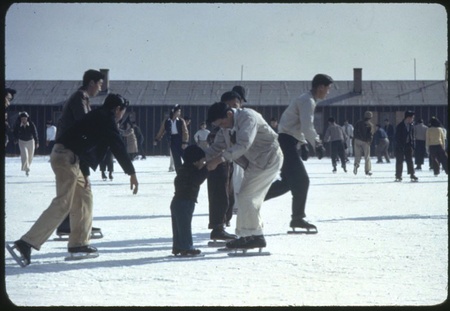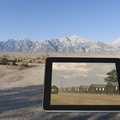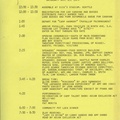2. 1943
Children's daily life—Winter
For the past month, the adults at Heart Mountain, including the administration and Japanese Americans, have been working together to build an ice rink by spraying water from fire hoses in several depressions within the camp. The long-awaited opening of the rink was on January 19th. The temperature had started to drop the week before, and on the opening day it recorded -33°C. Despite the extreme conditions, the adults worked together to make the rink as enjoyable as possible for the children. Of course, the children were delighted. Here is Bacon's report.
When it snowed, we made snowmen and had snowball fights. ... We even had an ice skating rink. Then all the kids needed skates. Learning to skate on the ice was a lot of fun. But it must have been a big financial strain on the parents to buy skates for all their kids. Of course, there were no department stores in the camps, so things like skates had to be ordered from mail-order catalogs from stores like Sears, Roebuck and Montgomery Ward. I imagine these stores probably made a lot of money from orders from the camps. 2
The photograph in this issue shows Billy, 3 years old, Billy, Bill Mambo's only son, being given a lesson in walking on ice, held tightly by a man who appears to be his uncle Sammy Itaya. The tightly clasped hands show Billy's complete trust, and the presence of his family, grandmother, grandfather, uncles and aunties, who showered him with unchanging love even in the concentration camp. For the adults around him, watching little Billy grow may have been a source of inspiration for their dreams for the future. The photograph was taken, of course, by Billy's father, Billy Mambo. He is not a professional photographer, but rather uses his camera as a hobby to record his son's growth and daily life in the camp. 3
Are Japanese people spoiled? —Winter
Shortly after the new year, Republican Congressman F. Leroy Johnson of California received a report without sufficient evidence that "Japanese people in the camps are receiving huge shipments of eggs, butter, sugar, coffee, meat, etc., while Americans living near the camps are having difficulty obtaining even their allotted amounts of food..." and submitted a resolution to Congress stating that "an investigation should be conducted into the truth of such reports." 4
So the House of Representatives (Congressional Un-American Activities) Committee on American Internment began to investigate the various camps. On the day the committee came to Minidoka, representatives from each grade level at the high school were to greet them at the entrance to the camp and show them around the school. Henry and his friends waited by the gate in the rain for two and a half hours, but the committee members never showed up. They hadn't even set foot inside the camp.
However, later, at Mrs. Pollack's suggestion, Henry got hold of the committee's report, which was included in the Congressional Record, and was astonished to see that the table was covered with linen tablecloths, and the waitresses served excellent food, which they ate with silver knives and forks. When he showed it to Mrs. Pollack, the teacher immediately remarked, "Oh, that's what the directors' dining room looked like." The committee members ate and wrote their reports only in the directors' area, outside the barbed wire fence. 5
The best thing I've eaten in the camp
At first, the amount of food in Gila River was even less than in the temporary camp. Jean's mother always saved some bread, took it back to the barracks, dried it, and put it in a brown paper bag. She prepared it as emergency food. I would have liked to have Jean's words heard by the Truman Commissioners:
...For my generation, the hunger we faced was a bigger problem. We stole potatoes from the storage warehouse, smeared them with mud, and roasted them over a campfire in the desert. My older brother Yoshiro knew someone who worked in the kitchen, and twice gave us bread and eggs. We had small bottles of seasonings, so my brother made an omelet on the hot plate. It turned out big enough that each member of my family got half an omelet sandwich. I ate mine slowly, taking as long as possible. Later, food rations increased and the constant hunger went away, but the best food we had in the camp was probably the potatoes roasted in the desert and the omelet sandwiches. 6
Record listening party at the library — Winter
Many libraries also held regular record listening sessions. In addition to the daily Topaz Times, Topaz also had a newspaper that was published every Saturday. The following notice appeared in the January 15, 1943 edition:
The January 20 concert at the library from 8 to 9 pm will feature the music of Franz Schubert. It will open with a Military March and Swan Song, followed by a Serenade, two songs by Marian Anderson, an Ave Maria and Swan Song, followed by a Fifth Song by Rellstab, Meine Schubert, before closing with Schubert's Symphony No. 8 in B minor, "Unfinished . "
Night volunteer
As the uncertainty of life continues, changes begin to appear among the children. In the diary of Kleinkopf, who was the Superintendent of Minidoka, there are frequent entries about groups of people skipping classes and passing around cigarettes in the high school library. By the way, what do you think these night volunteers are? Listen to this father's story.
There were various educational problems among the young people. There were educational facilities such as high school, junior high school, and elementary school, but the camp was not a place for education. My eldest son, Taira Keishi, would sometimes go out at dusk, saying, "I'm going to Valentia." I wondered what "Valentia" was, and when I looked it up, I found out that it meant sneaking onto farms and stealing things from the fields. Apparently he had been invited by some of his fellow Voluntia members. I thought the educational environment was poor, so I decided to leave the camp. 8
Notes:
1. Heart Mountain Sentinel, Vol. II No. 4, January 23, 1943.
2. Muller, Eric L (ed.). Colors of Confinement: Rare Kodachrome Photographs of Japanese American Incarceration in World War II , Chapel Hill: University of North Carolina Press, 2012.
3. I wanted to know when this photo was taken, so I checked the newspaper in the Heart Mountain internment camp. I found out the date the ice rink opened. It was January 19, 1943. Next, I wonder when Bill Manbo got his contraband camera. The head of the Heart Mountain camp wrote in the newspaper on December 24, 1942, "There are rules that prohibit foreigners (Japanese) in the camp from owning or using cameras, but I don't know of any rules that prohibit the evicted Americans (Nisei). However, it would be best to refrain from taking cameras outside the relocation area or taking photos of public facilities or military buildings." It is likely that Bill got his own camera soon after that. Around the same time as the head of the camp, there are also records that Nisei were allowed to use cameras in the Jerome and Granada internment camps. Therefore, it can be estimated that this photo was taken in January or February of 1943. The American Heritage Center at the University of Wyoming, which houses the original slides, dates the photo to 1942 to 1944.
However, cameras were still banned in camps located in military restricted areas, leaving some children with no proof of their lives for three years - a truly heartbreaking experience.
The photos of the camps taken by government photographers and Ansel Adams are all in black and white. Bill Mumbo's photos are interesting because they capture camp life from a prisoner's point of view and in vivid color. There was also a camera club at Heart Mountain at the time, and photos taken by other club members may still be quietly sleeping in a box in an attic somewhere.
Heart Mountain Sentinel, Vol. I No. 10, December 24, 1942.
Heart Mountain Sentinel, Vol. II No. 4, January 23, 1943.
4. The Minidoka Irrigator, Vol. II No. 4, January 13, 1943.
5. Henry Miyatake, interview by Tom Ikeda, May 4, 1998, Densho Visual History Collection, Densho.
"Dear Mrs. Breed" includes an account of a press conference held in April by First Lady Eleanor Roosevelt after she visited the Gila River camp, in which she said, "The sooner we can get these young people out of these camps, the better. They are not living in the luxurious conditions described in some of the reports.... I don't want to live like that."
6. See above, "Torn Identity: The Life of a Japanese-American Journalist"
7. Topaz Weekly Saturday Times, January 15, 1943.
8. Kazuo Ito, "80 Years of American Spring and Autumn: Seattle Japanese Association 30th Anniversary Commemorative Book," Seattle Japanese Association, 1982
Many Issei came into contact with English for the first time when they came to America, and learned it only by the sounds that came through their ears. That's probably why they heard "Volunteer." It gives you a sense of the atmosphere at the time. Even before the loyalty registration, loyalty to America was recognized, there was work, and people with sponsors could leave the internment camps. This father must have been determined to look for work in earnest.
*Reprinted from the 135th issue (October 2013) of the quarterly magazine "Children and Books" published by the Children's Library Association.
© 2013 Yuri Brockett







